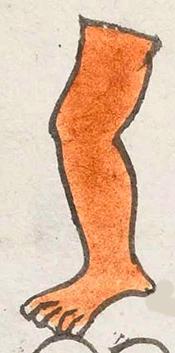moquetza (Mdz12r)
This element of an upright leg represents the verb moquetza (to stand or to be set up). It has been carved from the compound sign for the place name, Tonalli Imoquezayan.
Stephanie Wood
The deer leg from the Codex Mendoza, in a similar way, represents the verb to jump. Both the human leg and the animal leg have these associations with the actions (jumping, standing) that legs can perform. But, in the compound glyph in which this standing leg is found, the reference is to the sun or the day and the place where it would be set up, perhaps. See our entry for moquetza in the Online Nahuatl Dictionary.
Stephanie Wood
c. 1541, but by 1553 at the latest
Stephanie Wood

moquetza, to stand, https://nahuatl.wired-humanities.org/content/moquetza
to stand (verb)
Stephanie Wood
Codex Mendoza, folio 12 recto, https://digital.bodleian.ox.ac.uk/objects/2fea788e-2aa2-4f08-b6d9-648c00..., image 34 of 188.
The Bodleian Libraries, University of Oxford, hold the original manuscript, the MS. Arch. Selden. A. 1. This image is published here under the UK Creative Commons, “Attribution-NonCommercial-ShareAlike 3.0 License” (CC-BY-NC-SA 3.0).
